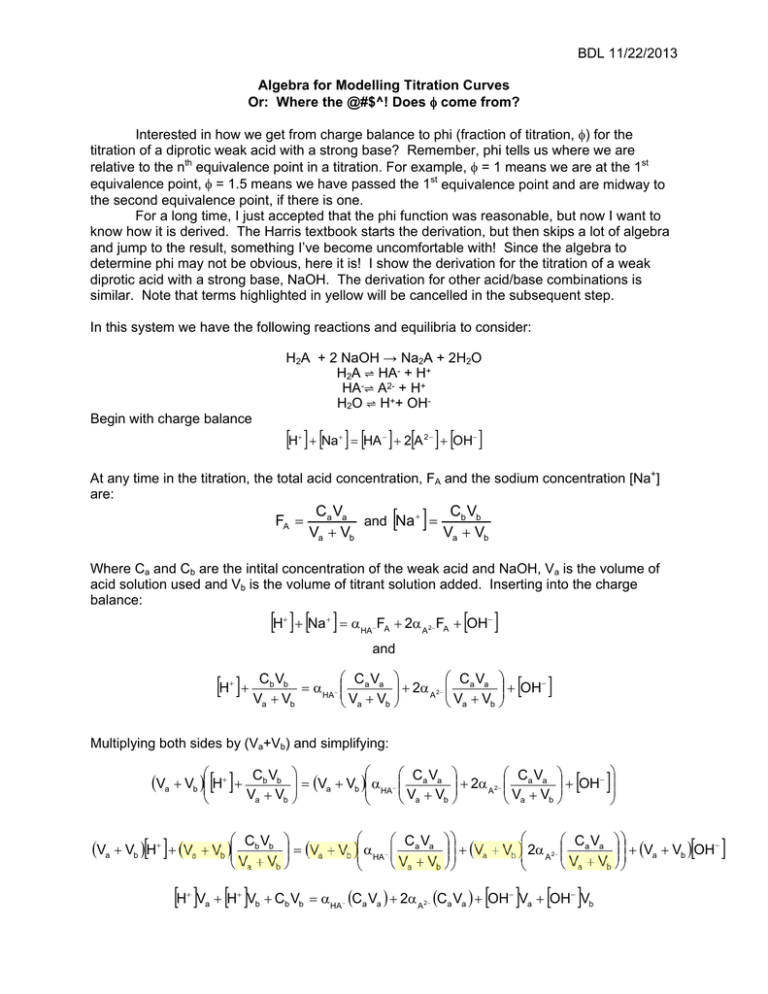Document 10460270
advertisement

BDL 11/22/2013 Algebra for Modelling Titration Curves Or: Where the @#$^! Does come from? Interested in how we get from charge balance to phi (fraction of titration, ) for the titration of a diprotic weak acid with a strong base? Remember, phi tells us where we are relative to the nth equivalence point in a titration. For example, = 1 means we are at the 1st equivalence point, = 1.5 means we have passed the 1st equivalence point and are midway to the second equivalence point, if there is one. For a long time, I just accepted that the phi function was reasonable, but now I want to know how it is derived. The Harris textbook starts the derivation, but then skips a lot of algebra and jump to the result, something I’ve become uncomfortable with! Since the algebra to determine phi may not be obvious, here it is! I show the derivation for the titration of a weak diprotic acid with a strong base, NaOH. The derivation for other acid/base combinations is similar. Note that terms highlighted in yellow will be cancelled in the subsequent step. In this system we have the following reactions and equilibria to consider: H2A + 2 NaOH → Na2A + 2H2O H2A ⇌ HA- + H+ HA-⇌ A2- + H+ H2O ⇌ H++ OH- Begin with charge balance H Na HA 2A OH 2 At any time in the titration, the total acid concentration, FA and the sodium concentration [Na+] are: FA Ca Va Cb Vb and Na Va Vb Va Vb Where Ca and Cb are the intital concentration of the weak acid and NaOH, Va is the volume of acid solution used and Vb is the volume of titrant solution added. Inserting into the charge balance: H Na HA FA 2 A 2 FA OH and H VC VV b a b b C V C V HA a a 2 A 2 a a OH Va Vb Va Vb Multiplying both sides by (Va+Vb) and simplifying: Va Vb H C V C V Cb Vb Va Vb HA a a 2 A 2 a a OH Va Vb Va Vb Va Vb C V C V Cb Vb Va Vb HA a a Va Vb 2 A 2 a a Va Vb OH Va Vb Va Vb Va Vb Va Vb H Va Vb H V H V a b Cb Vb HA Ca Va 2 A 2 Ca Va OH Va OH Vb BDL 11/22/2013 Collecting “a” terms on one side and “b” terms on the other: Cb Vb H Vb OH Vb HA Ca Va 2 A 2 Ca Va OH Va H Va Dividing both sides by CaVa: Cb Vb H Vb OH Vb HA Ca Va 2 A 2 Ca Va OH Va H Va Ca Va Ca Va Ca Va Ca Va Ca Va Ca Va Ca Va Simplifying: Cb Vb H Vb OH Vb OH H HA 2 A 2 Ca Va Ca Va Ca Va Ca Ca Now we have something that has (CbVb/CaVa) in it, but we still have Vb appearing in other terms and we need to somehow get rid of it in all terms except for (CbVb/CaVa). I struggled with this for a while, but it turns out that we need to factor (CbVb/CaVa) out of the left side (This part isn’t very obvious, but we need to get to the correct form for phi). Factoring the left side and simplifying: Cb Vb Ca Va H Vb OH Vb OH H 1 HA 2 A 2 Cb Vb Cb Vb Ca Ca Cb Vb Ca Va H OH 1 Cb Cb HA 2 A 2 OH H Ca Rearranging: Cb Vb Ca Va HA 2 A 2 OH H Ca H OH 1 Cb Cb Ca Which can be rewritten to match the format in the text: Cb Vb Ca Va HA 2 A 2 H OH Ca H OH 1 Cb Ca




